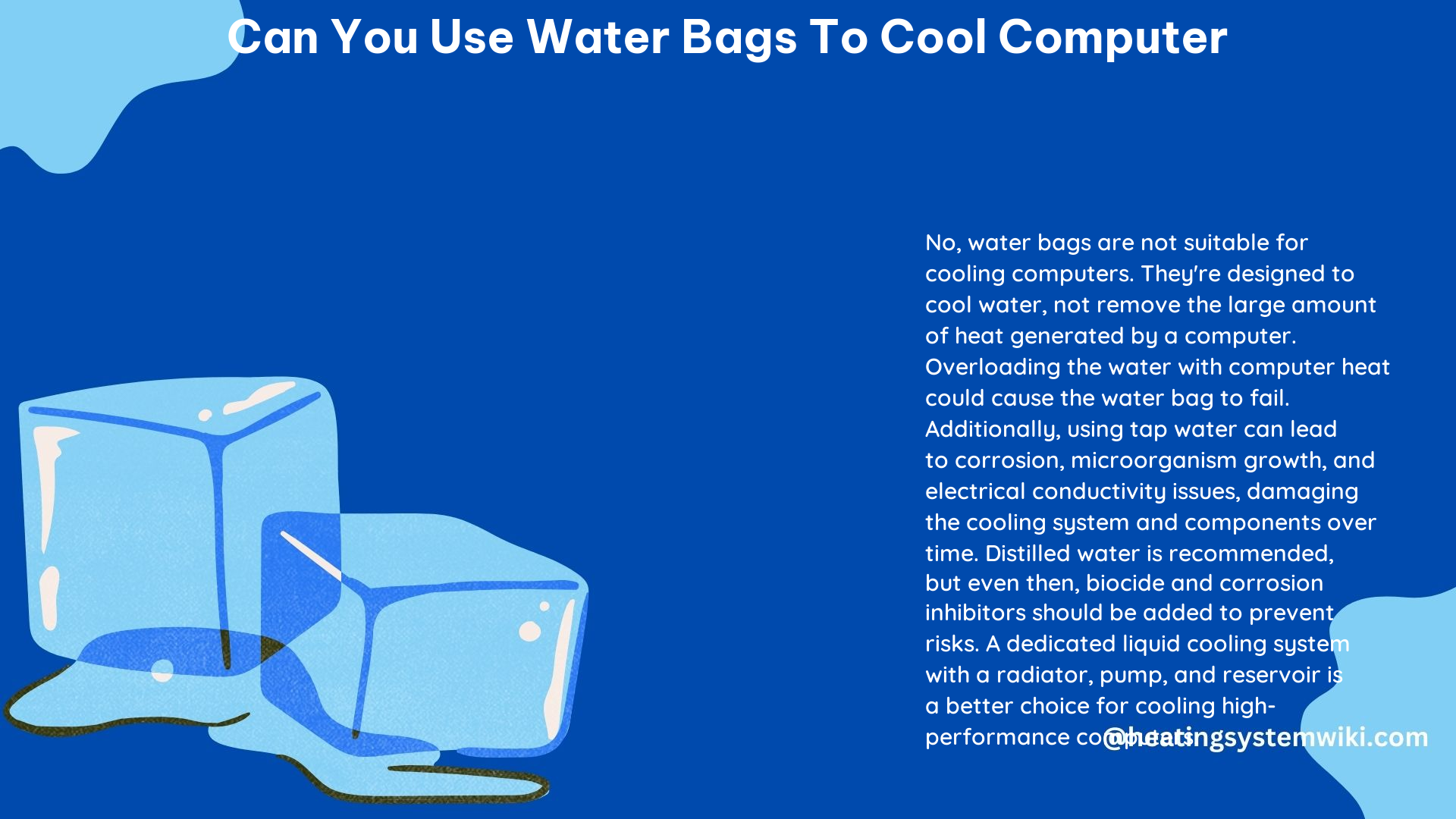The idea of using a water bag to cool a computer is not practical or effective. A water bag, such as a water dispenser or a water cooler, is designed to cool water, not to remove the large amount of heat that a computer generates. The heat output of a computer can range from 50 watts for a basic desktop to over 300 watts for a high-performance gaming rig, which is much greater than the cooling capacity of a water bag.
Understanding the Limitations of Water Bags for Computer Cooling
-
Insufficient Cooling Capacity: A typical water bag or water dispenser has a cooling capacity of around 100-200 watts, which is not enough to effectively dissipate the heat generated by a computer. Attempting to use a water bag for cooling could result in overloading the system, leading to inadequate cooling or even damage to the computer.
-
Condensation Concerns: When using water cooling for a computer, there are concerns about condensation. At idle, the computer components may be chilled below ambient temperatures, which can lead to condensation and potentially damage the internal components. At load, a water bag may not provide enough cooling to maintain the desired temperature, resulting in thermal throttling or system instability.
-
Lack of Specialized Components: Water bags and water dispensers are not designed for computer cooling. They lack the specialized components found in custom water-cooling loops or all-in-one (AIO) water coolers, such as water blocks, radiators, pumps, and reservoirs, which are essential for effectively dissipating heat from a computer.
Effective Water Cooling Solutions for Computers

If you’re considering water cooling for your computer, it’s important to use a system specifically designed for this purpose. There are two main options:
- Custom Water-Cooling Loop:
- Water blocks for CPU, GPU, and other heat-generating components
- Radiator for heat dissipation, typically ranging from 120mm to 480mm in size
- Water pump to circulate the coolant, with flow rates of 60-300 liters per hour
- Reservoir to store the coolant, typically with a capacity of 100-500 milliliters
- Tubing to connect the components, usually made of flexible PVC or rigid acrylic/PETG
- Coolant, which is typically a water-based solution with additives for corrosion inhibition and biocide
-
Fittings and connectors to assemble the loop
-
All-in-One (AIO) Water Cooler:
- Pre-assembled water block, radiator, pump, and reservoir
- Coolant pre-filled in the system
- Fans to assist in heat dissipation, typically ranging from 120mm to 360mm in size
- Mounting hardware for easy installation on the CPU socket
DIY Water Cooling Guide
If you decide to build a custom water-cooling loop, follow these steps:
-
Choose the Right Components: Select a water block, radiator, pump, reservoir, tubing, and coolant that are compatible with your computer’s components and case. Consider factors like the size of your case, the heat output of your CPU and GPU, and the overall cooling requirements.
-
Plan the Loop Layout: Determine the best route for the tubing to connect the components, considering the space available in the case and the flow rate of the coolant. This will ensure efficient heat dissipation and prevent any potential leaks.
-
Install the Water Block: Carefully attach the water block to the CPU or GPU, ensuring a secure and stable connection. Follow the manufacturer’s instructions to ensure proper installation.
-
Install the Radiator: Mount the radiator in a location with good airflow, such as the front, top, or rear of the case, using the provided mounting hardware.
-
Install the Pump and Reservoir: Place the pump and reservoir in a convenient location, ensuring they are securely mounted and connected to the water block and radiator.
-
Fill the Loop with Coolant: Follow the manufacturer’s instructions for filling the loop with coolant, ensuring all air is removed from the system. Use distilled water or a pre-mixed coolant solution to prevent corrosion and bacterial growth.
-
Test the System: Run the system and monitor temperatures to ensure proper operation and adequate cooling. Check for any leaks and make adjustments as needed.
By following these steps and using a custom water-cooling loop or an AIO water cooler, you can effectively cool your computer without the limitations of a water bag.
References:
– Using a Water Dispenser to Chill My Computer
– Water Cooling vs. Air Cooling
– Why You Should Use Distilled Water for Liquid Cooling Your PC
